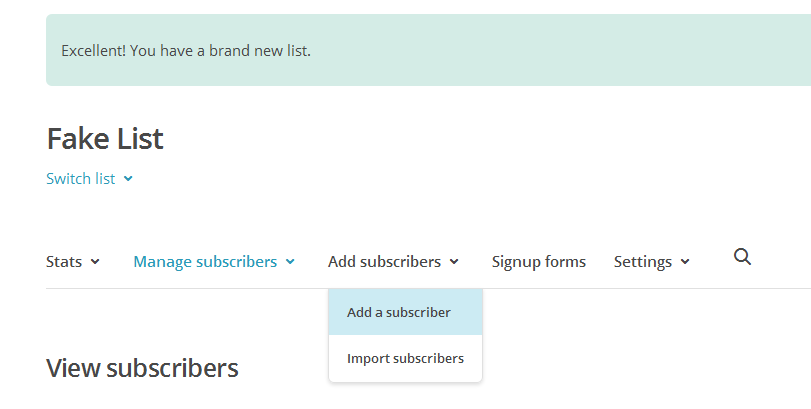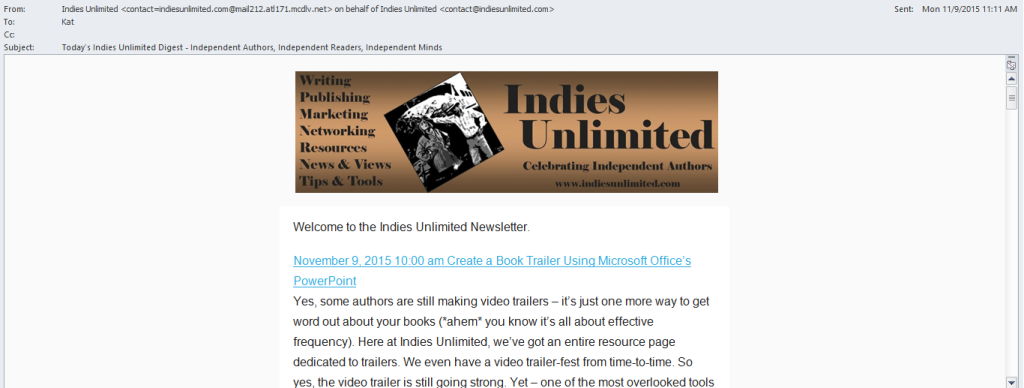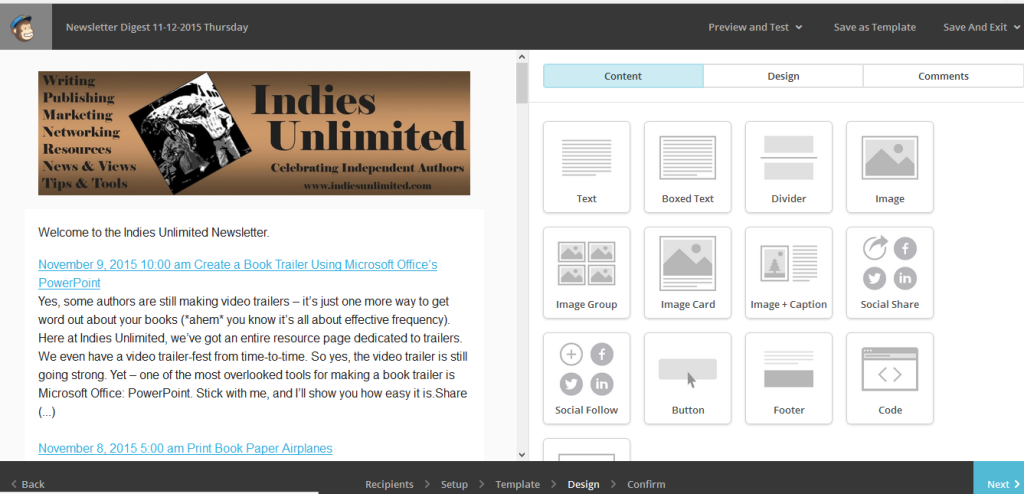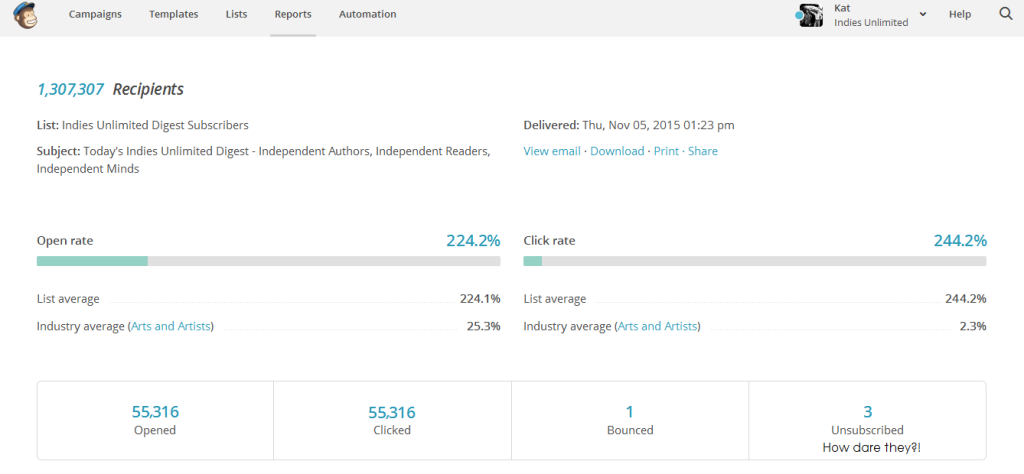 What is MailChimp, and what is it good for? Of course, everyone does things differently, so I thought I’d offer a brief rundown on how I use Mailchimp to manage my mail-outs in a very basic way, and how it might be useful to you. This is not a review or an IU official endorsement. It is a slice of life that perhaps you can learn from. If you want to know more about creating a newsletter, see Jim Devitt’s post, Developing the Perfect Author Newsletter.
What is MailChimp, and what is it good for? Of course, everyone does things differently, so I thought I’d offer a brief rundown on how I use Mailchimp to manage my mail-outs in a very basic way, and how it might be useful to you. This is not a review or an IU official endorsement. It is a slice of life that perhaps you can learn from. If you want to know more about creating a newsletter, see Jim Devitt’s post, Developing the Perfect Author Newsletter.
MailChimp is an email marketing service. You write your email; they send it to everyone you want and keep track of what happens to it after that. As far as the sending part, they don’t do much that you couldn’t do in your normal email program. For the analytical part, they provide information that I have no idea how to find myself, and this is the main reason I use the service. And on top of it, my newsletters look more professional.
Creating a Mailing List
The first thing you do is choose your recipients. Once you have put these in, either by entering them individually or importing from another program (not that hard), they are always available. You can divide them into separate groups and segments and manipulate them in many ways. However, if all you’re doing is sending a message to everyone, you just check the appropriate box and move on. Choosing the Template
Choosing the Template
Now you create your letter. The main advantage here is that when you or I send a letter on our computer’s mail program, it looks like a plain old email. With MailChimp, you can create a professional-looking post with your company logo, pictures, hot buttons and all sorts of stuff on it. MailChimp provides a number of templates, from simplest text like a normal email to several complex sets of columns and boxes. Once you have made your choice you get a preview of what your blank email will look like, on both computer and mobile. If you like it, you move on to filling the blanks. Writing the Letter
Writing the Letter
You write your email by filling in text boxes and dragging-and-dropping the various elements available, with options for links and alternate text for clients whose machines don’t load images. And if you don’t understand what “alternate text” is, neither did I, but there’s a chimp in a convenient popup “Help” image that explains it. Checking It Over
Checking It Over
Once you’re happy with what you have made, you move on to the Preview and Test mode, which again gives you a preview for computer and mobile screens, this time with all your material on it. You can also send a test email to yourself or a friend to see what it looks like in the real world. As with the rest of the program, there are all sorts of extra things you can do, many of which I haven’t explored myself, but they aren’t necessary to the average user.
As with the rest of the program, there are all sorts of extra things you can do, many of which I haven’t explored myself, but they aren’t necessary to the average user.
Send
When you have checked and double-checked you push the “Send” button. Now you get to “high-five” the Chimp, and the email is sent to all your chosen recipients.
Analytics
Once your message is sent you wait a day or so and then check your reports. The basic information you get for each post is number of opens, number of clicks on the buttons or hypertext in the post, and a comparison to industry averages for these. You can also do Comparative Reports, Automated Emails, and Inbox Inspections. I have no idea what these are because I don’t use them, but I’m sure that if I wanted to find out, the impish Chimp would pop up and tell me all about them.
You can also do Comparative Reports, Automated Emails, and Inbox Inspections. I have no idea what these are because I don’t use them, but I’m sure that if I wanted to find out, the impish Chimp would pop up and tell me all about them.
Other Advantages.
- On a legal basis, it is required (at least in Canada) that mass emails have an “unsubscribe” button at the bottom. It is certainly polite wherever you live. MailChimp takes care of this process, including ratting on the miscreant, so you know who has abandoned you. The chimp also writes a sympathetic little message to the tune of “These things happen, don’t worry about it.”
- There are also signup forms available that can be easily inserted into your website or Facebook page in various ways. This means MailChimp takes care of your subscribers from cradle to grave, so to speak, and all you have to do is connect with them.
- You can get an app to run MailChimp on your mobile device as well. I found this more difficult to use, but when you’re travelling, it’s worth it.
- The last advantage for some of us is that the MailChimp people, as you may have already gathered, are a relaxed bunch with a quirky sense of humour. While providing a professional product, they keep you amused and entertained with the antics of the Chimp.
My final comment: This is a great basic service, not too difficult to use, and in my experience very reliable for the casual user. It is free up to 2,000 subscribers and 12,000 emails a month. They have a professional level (and some other pay levels) available for a monthly fee, which I assume provides all sorts of bells and whistles that I don’t understand or perhaps need, but I am grateful for those professionals who pay for it and keep the service operating free for the rest of us.
To keep things fair, I’ll now give you some information on Constant Contact
In his article entitled Developing the Perfect Author Newsletter, Jim Devitt says he prefers Constant Contact, a service that provides basically the same services, so I joined and checked them out. There are some differences:
- Constant Contact is free for the first 60 days, but then you have to pay $20 a month for the basic, $45 for the professional level.
- I found Constant Contact simpler to use, even on the first try.
- Constant Contact has a catalogue of templates of all sorts, from the basic ones like MailChimp, to various holidays, occasions, merchants, and other ideas.
- Constant Contact has a big library of photos at $2.99 each per use. They have more for the Pro level customers.
I have no information on the reliability of Constant Contact, but at a first look-through, it seems to be a good service. However, it provides more than I need for more than I want to spend. MailChimp has been very reliable and does everything I want for the best price: free. Both look like they have room for me to expand as I learn more about their services, and should my requirements increase.
However, if you go to Top Ten Reviews, neither of these services is even mentioned. There are ten more in that article that someone else can look at and report back on. Top Ten Reviews is a site worth exploring, because their reviews look thorough and logical. However, as with all the other commercial reviewers, you have no idea whether they have been paid or are biased in some other way.
Since this is Indies Unlimited, you can be pretty sure I’m not getting paid. And like Jim, I’m happy with familiarity. I’ll stick with the Chimp.

Nice summary, Gordon. There might be better services out there, but I’m not sure you can beat MailChimp’s price. I think for anyone looking to get started with their mailing list and test the waters, MailChimp is great. It’s free for fewer than 2,000 subscribers, and has a great deal of functionality. Of course, I love the data they provide, in terms of open rate and that sort of thing.
Sometimes “free” means you get what you pay for, but I have found even the free Chimp service is very professional.
Excellent review and advice.
I joined MailChimp a little while ago and have yet to send my first group email. I’m waiting for something interesting to say — could be a while. 😉
Thanks again.
Well, if you’ve got a group to send to, you’re over half way there. I try not to spam my list, because I hate it so much when it happens to me. (unless it’s IU)
Nice review and run-down, Gordon, thank you. I’ve high-fived the chimp a few times and found it convenient, although it gets a little cranky on older browsers. But don’t we all.
Terrible to be a starving artist, ain’t it?
Nicely done Gordon. I use Mailchimp but I must say it confuses the heck out of me. This will help.
I happened to notice as I was sending out an email today that they have an Amazon announcement template. You can even link directly to your book with a buy button. It was in the advanced templates section (I think). You can also switch the hyperlink on the buy buttons with your affiliate link. I used it and was in and out in minutes. Might be something to consider.
Great article, thank you.
There you go. I just learned something new, as well.
Thanks, Martin
Thanks, Gordon. I’ve been curious about Mail Chimp and whether I might benefit from signing up for the service. You answered all of my questions! I had never heard of Constant Contact before–but, I have now. 🙂
I hadn’t heard of Constant Contact either, before I started researching this topic. Now I keep getting spam from them!
Hi, Gordon – I found the Chimp difficult to work with, but this is helpful. I finally decided to use the email service that came with my website host, Wix dot com. It’s more intuitive (for dummies, lol) than MailChimp, and it doesn’t cost anything unless I want to upgrade. The only advantage to upgrading, as I see it, is that I could send more than four “shoutouts” per month. I don’t plan to do that, so I’ll keep it the way it is. Thanks for summarizing and ‘splaining!
I agree that MailChimp takes some getting used to. No limit on posts, that I’m aware of.
Any information on whether/how they protect your mailing list from being stolen by spammers?
As with most online companies, they list a bunch of procedures that none of us understand, so we have to take them at their word. I mean, “Passwords are salted and hashed.” If this was Denny’s breakfast bar, I’d understand that.
Their security page is: http://kb.mailchimp.com/accounts/management/about-data-security?_ga=1.214394455.1902597349.1360262209 if you know enough to go into it.
I use the paid MailChimp for my author newsletter. I started out free, but I wanted the automation that comes with the paid service. I’ve been with them over a year now, and I’ve always been happy.
To be fair, I’ve used both Constant Contact and Robly for mailing lists at my work, where the budget is slightly larger, and I have absolutely no complaints about either of those services. They’re all great email providers, and while each has a slightly different set of tweaks, I found that MailChimp suits my purposes as an author. 🙂
Thanks for a more experienced input, Stephanie. You’re obviously way ahead of most of us 🙂
It helps that my day job is online marketing for a small museum. 😀 I’m able to learn all these skills while getting paid, and then I can apply them to my personal marketing as well.
I have creating a Chimpmail list on my to-do list. I use it where I work (local arts council) and find it easy to use.
Ah, you lucky people that learn all this stuff and get paid at the same time. I’m sure your local arts council is a big spender:-)